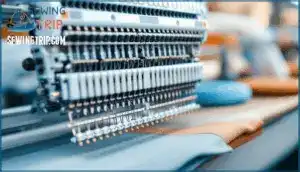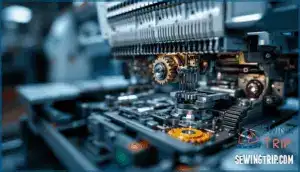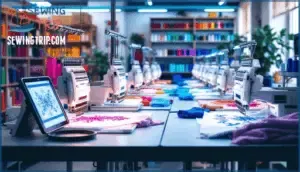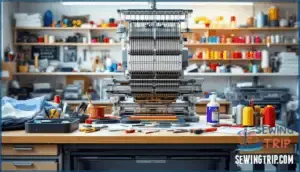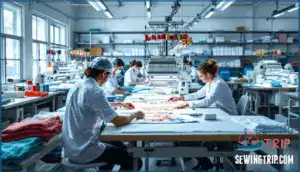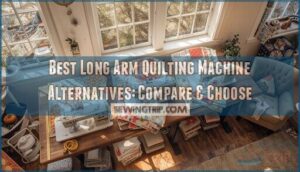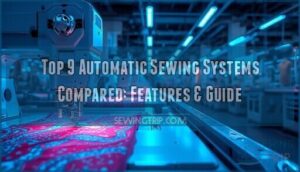This site is supported by our readers. We may earn a commission, at no cost to you, if you purchase through links.
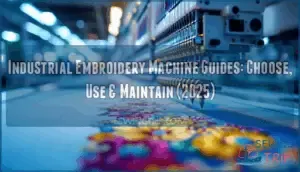 A single thread break at 3 a.m. can cost you three hours of production time and a customer deadline. Industrial embroidery machines don’t forgive guesswork—wrong needle counts cripple your workflow, poor maintenance schedules drain profit margins, and software mismatches create bottlenecks that ripple through every order.
A single thread break at 3 a.m. can cost you three hours of production time and a customer deadline. Industrial embroidery machines don’t forgive guesswork—wrong needle counts cripple your workflow, poor maintenance schedules drain profit margins, and software mismatches create bottlenecks that ripple through every order.
The gap between choosing equipment that scales your business and buying an expensive paperweight comes down to understanding specifications, maintenance protocols, and production optimization before you commit.
This guide walks you through selection criteria, troubleshooting methods, and scaling strategies that keep commercial embroidery operations running profitably.
Table Of Contents
Key Takeaways
- Choosing the right industrial embroidery machine depends on matching needle count (6-15) and stitch speed (800-1,300 SPM) to your actual production volume and color-change needs, not just chasing impressive specs that won’t improve your workflow.
- Brand reliability and service infrastructure matter more than features—Tajima resolves 95% of issues by phone, and warranty coverage ranges from 1 to 10 years, directly impacting your downtime costs and long-term profitability.
- True ownership costs include hidden expenses like thread consumption, stabilizer stock, and electrical demands, so run a break-even analysis before purchasing—a dual-head machine processing 50 garments daily can pay for itself in eight months with proper workflow optimization.
- Preventive maintenance schedules, routine cleaning after every shift, and matching thread type to fabric weight prevent the costly breakdowns and production delays that kill profit margins faster than any equipment upgrade.
Choosing The Right Industrial Embroidery Machine
Choosing the right industrial embroidery machine isn’t about chasing the flashiest specs—it’s about matching your equipment to your actual production needs.
You’ll need to weigh several technical factors before you commit to a purchase. Let’s break down what matters most when you’re sizing up your options.
Key Features and Specifications
When you’re shopping for an industrial embroidery machine, it’s easy to get lost in the spec sheets and sales pitches, but knowing which features actually matter can save you thousands of dollars and countless headaches down the road. Focus on needle technology first, because quality stitches depend on precision alignment.
Check if the machine offers speed control options, reliable automation features, and frame compatibility with standard hoops. Look for built-in designs that match your production needs, and don’t overlook operation and adaptability for diverse projects efficiently.
Needle Count and Stitch Speed
The needle count directly controls how many colors you can run without stopping to rethread, and stitch speed determines whether you’ll finish jobs in hours or days.
Here’s what you need to balance for production efficiency:
- Needle configurations from 6 to 15 needles suit different commercial embroidery machine setups
- Stitching speed ranges from 800 to 1,300 SPM across embroidery technology platforms
- Stitch quality decreases if you push speed optimization beyond machine capabilities
- Production volume grows when you match needle count to your typical color changes
- Production efficiency improves when speed and precision work together, not against each other
Brand Reliability and Support
After you’ve matched needle count to your color demands and locked in the right stitch speed, you’ll want machines that won’t let you down when deadlines hit. Brand longevity matters—Tajima’s 40-year track record and Barudan’s heavy-duty Pro Series prove reliability under pressure.
Support infrastructure separates the winners from the frustration: Tajima resolves 95% of service issues by phone, and warranty coverage varies from Brother’s 1-year to Happy’s 10-year manufacturer’s guarantee. Service accessibility keeps you running—fast parts shipping and certified repair networks minimize downtime.
User satisfaction data consistently ranks Tajima and Barudan highest for commercial embroidery machine selection, with operators running 136 heads six days a week for decades. To process large and complex orders, consider machines with a large embroidery field. Strong brand reliability and support turn embroidery machine maintenance from a gamble into a predictable advantage.
Machine Durability and Build Quality
Once you’ve locked down a brand with proven support, you’ll need to know if the machine itself can survive years of thread breaks, fabric pulls, and back-to-back production runs. Frame stability and vibration resistance determine whether your stitch quality holds up at 1,200 SPM.
Look for material strength in the tubular frame and stress testing data—commercial embroidery machines built with cast-aluminum components show longer component lifespan than plastic housings.
Durability isn’t marketing talk; it’s your shield against embroidery machine maintenance headaches that kill profit margins.
Durability separates machines that survive years of production from those that become expensive maintenance nightmares
Smart Purchasing and Financial Planning
Buying an industrial embroidery machine isn’t just about picking the shiniest model—it’s about making the numbers work for your business. You need to balance upfront costs, ongoing expenses, and realistic revenue projections before signing anything.
Let’s break down the financial side so you can invest smart and avoid buyer’s remorse.
Pricing and Budgeting Tips
Setting your budget for an industrial embroidery machine isn’t just about the sticker price—it’s about calculating the true cost of ownership over time, including parts, maintenance, and the revenue you’ll need to justify the investment.
Factor in hidden costs like thread consumption, stabilizer stock, and electrical demands when planning your budget allocation. Run a production cost analysis to see how many orders you’ll need monthly to break even.
Don’t overlook price negotiation leverage or cost savings through bulk purchases—your machine investment strategy should drive real ROI analysis, not just impressive features.
Financing Options and Distributors
If you’re eyeing a $15,000 machine but don’t have the cash upfront, financing through equipment leasing companies or manufacturer payment plans can turn that investment into manageable monthly payments without draining your working capital.
Compare lease vs. buy terms carefully—leasing preserves resale value flexibility, while financing builds equity in your embroidery business.
Check distributor reputation and ask about government grants for small businesses; these can offset your machine investment strategy and improve your ROI analysis during machine selection.
ROI Analysis for Commercial Buyers
How quickly does your commercial embroidery machine pay for itself? Understanding payback period helps you make smarter investment strategies and predict when revenue generation will cover your initial costs. A key factor in this calculation is understanding the payback period for your investment.
- Break-even timeline: A dual-head machine processing 50 garments daily can reach payback in eight months, while larger units may take 1–5 years depending on your embroidery business scale
- Profit margins matter: Custom orders deliver 50–60% margins, far exceeding the 20–30% from mass production runs in commercial embroidery production
- Hidden cost savings: Efficient models save $1,900 in electricity over five years, and thread waste reduction cuts material costs by 22%
- Revenue optimization: Multi-head systems double output, accelerating your return during embroidery machine selection
- Smart embroidery business management: Digital workflow and diversified services boost profits by $5,800–$16,500 annually, improving overall ROI
Optimizing Production Workflow
Getting the most from your machine isn’t just about speed—it’s about setting up a workflow that keeps quality high and bottlenecks low. The right combination of software, materials, and setup techniques can turn your embroidery operation into a well-oiled machine.
Let’s walk through the key areas that’ll help you improve production and avoid the headaches that slow you down.
Workflow Efficiency Techniques
You can’t win a speed race if you’re fumbling with setup between every order, so let’s talk about streamlining your production from design to finished product. Start with Layout Optimization—arrange your Commercial Embroidery Machine stations to minimize movement between tasks.
Process Standardization means creating repeatable routines for hooping, threading, and quality checks.
Automation Integration, like auto-trimmers and color-change alerts, keeps your Textile Production Efficiency high while Waste Reduction practices save material costs in Apparel Manufacturing Technology settings.
Embroidery Software and Digitizing
Strong Embroidery Software and rock-solid Digitizing skills turn artwork into stitch files that your machine can execute flawlessly. AI Digitizing tools now cut conversion time by 60 percent for simple patterns, while Manual Digitizing gives you node-level control for intricate Embroidery Design work.
File Compatibility across 70-plus formats prevents bottlenecks, though Software Costs above $2,000 can challenge smaller shops.
Blending Automation Levels with hands-on editing in your Embroidery Software Solutions balances speed with precision in Digitizing and Design workflows.
Thread, Bobbin, and Stabilizer Selection
Choosing the right Thread Type, Bobbin Weight, and Stabilizer Grade is like picking tires for a race car—mismatched materials cause tension breaks, puckered fabric, and wasted production hours.
Polyester Embroidery Thread suits stretch fabrics, while rayon delivers color-matching brilliance on stable knits.
Match Bobbin Tension to your top thread weight, and pair cut-away Stabilizers with high-stitch-density designs for Material Compatibility that prevents puckering and thread shredding.
Hooping and Accessory Recommendations
Once your thread and stabilizer are dialed in, the wrong hoop or sloppy hooping technique can still wreck a job faster than a bird strike on a windshield.
Invest in quality Embroidery Hoops matched to your fabric weight—tubular hoops prevent Hoop Burn on delicates, while magnetic systems speed Multi-hooping setups.
An Echidna Hooping Station guarantees drum-tight Fabric Stabilization every time, reducing puckering and registration drift across complex Placement Techniques.
Maintenance and Troubleshooting Essentials
Keeping your machine running smoothly isn’t rocket science, but it does take consistency. A little preventive care goes a long way toward avoiding headaches and protecting your investment.
Let’s walk through the essentials that’ll keep your embroidery operation humming along without unexpected interruptions.
Routine Cleaning and Care
Regular cleaning isn’t just busywork—it’s the difference between a machine that hums through orders and one that sits idle during your busiest week.
You’ll want to remove lint after every shift, oil mechanisms weekly following your embroidery machine buying guide, inspect needle care and tension settings daily, and establish preventative maintenance schedules that keep your commercial embroidery machine running smoothly through peak production seasons.
Common Machine Issues and Fixes
Even the best-maintained machine will throw you a curveball, so knowing how to diagnose and fix the most common issues saves you hours of frustration and keeps your production schedule on track. Thread breaks often stem from incorrect tension adjustments or burrs on the needle plate, while needle problems usually mean you’re using the wrong size or a bent tip. Here’s what you’ll encounter most:
- Thread breaks: Check your thread path, re-thread carefully, and verify your tension settings match your fabric weight
- Needle problems: Replace bent or dull needles immediately; match needle size to thread weight for better stitch quality
- Tension adjustments: Test on scrap fabric first; commercial embroidery machines need different settings for various materials
- Motor issues and sensor failures: Listen for unusual sounds, check error codes in your embroidery machine buying guide, and call your technician for electrical problems
Preventing Downtime and Costly Errors
Fixing problems on the fly is one thing, but stopping them before they happen means your machine runs longer, your deadlines stay intact, and your repair bills stay low.
Build maintenance schedules around your production volume, train operators on proper bobbin management and needle selection, and use quality control checks to catch stitch quality issues early.
Predictive maintenance and workflow optimization are your best tools for operational superiority and error prevention.
Scaling Your Embroidery Business
Growing your embroidery business means balancing demand with smart upgrades and exploring new service lines. You’ll need to know when to add machines, how to stay ahead of industry shifts, and where to expand your offerings.
Here’s what to focus on as you scale up.
Managing Production Growth
When your order board starts filling faster than you can stitch, you’ll know it’s time to scale up, but growth without a plan can turn profit into chaos. Here’s how you manage embroidery business growth without sacrificing quality control:
- Capacity planning helps you forecast machine hours and prevent bottlenecks in commercial embroidery production
- Order management systems track jobs from digitizing through shipping, streamlining workflow optimization
- Employee training guarantees consistent stitch quality as you add operators to your floor
- Automation integration reduces manual tasks, letting you focus on embroidery business management instead of paperwork
Advanced Machine Upgrades
Upgrading your industrial embroidery machine isn’t just about buying newer equipment—it’s about strategically adding capabilities that multiply your output without multiplying your headaches.
Consider software integration that links digitizing directly to your machine controller, eliminating file transfer delays. Automation options like thread trimmers and automatic color changes reduce operator intervention.
Enhanced sensors prevent thread breaks before they ruin jobs. Motor upgrades boost stitch speed without sacrificing precision.
Laser add-ons enable positioning accuracy that transforms embroidery machine selection from basic to sophisticated industrial embroidery technology, making your existing equipment work smarter.
Industry Trends and Future Technologies
As AI Integration reshapes textile decoration methods, your shop can’t afford to stay behind. Modern Embroidery Software Solutions now leverage machine learning to auto-correct stitching errors, improve thread paths, and predict maintenance needs. Meanwhile, Sustainable Practices aren’t just marketing—eco-friendly threads and energy-efficient operations attract conscious clients while cutting costs.
Here’s what’s driving Apparel Decoration Trends forward:
- AI Integration – Real-time pattern improvement and error detection boost quality
- Automation Advancements – Voice controls and wireless monitoring reduce labor
- E-commerce Growth – Online custom design uploads expand your market reach
- Customization Demand – Individualized embroidery commands premium pricing
- Digitizing and Design – CAD integration streamlines workflow from concept to stitch
These Industrial Embroidery Technology shifts create opportunities for shops that adapt quickly, turning emerging capabilities into competitive advantages.
Custom Embroidery Service Expansion
Scaling from a single-head setup to a full-service embroidery operation demands more than just buying extra machines—you’re building a business model that turns creative requests into consistent revenue streams.
Start by analyzing Market Demand in your region, then establish Service Pricing that covers Order Fulfillment costs while funding Business Growth. Strong Marketing Strategies and Customer Acquisition tactics—paired with reliable Embroidery Software for Digitizing and Design—transform your Custom Embroidery Services into a sustainable Embroidery Business.
| Growth Factor | Action Steps |
|---|---|
| Market Demand | Survey local businesses, schools, sports teams for volume orders |
| Service Pricing | Calculate thread, labor, machine time; add 40-60% markup |
| Marketing Strategies | Build portfolio website, partner with print shops, attend trade shows |
Frequently Asked Questions (FAQs)
What permits or licenses are required for operation?
Business operations, big or small, begin with proper permissions. Your embroidery business needs standard business licenses, zoning compliance for commercial embroidery operations, and adherence to federal regulations, state requirements, and local ordinances governing apparel manufacturing and industrial embroidery activities.
How much floor space does each machine need?
Most industrial embroidery machines need between 6 to 10 feet of floor space for the machine footprint itself, plus additional workspace layout room for accessibility needs and ergonomic considerations.
Plan for expansion planning when configuring your commercial embroidery setup.
What electrical requirements do industrial machines have?
Most industrial embroidery machines need 110-120V or 220-240V power, depending on the model. Single-head machines commonly draw 5-10 amps, while multi-head units require dedicated 20-30 amp circuits with proper grounding and surge protection for safe operation.
Can machines handle specialty threads like metallic?
Most industrial machines use metallic thread with proper tension adjustments and needle selection. You’ll need to slow stitch speed, use metallic-specific needles, and adjust top tension to prevent thread breaks.
Some budget machines struggle with specialty thread types.
What training resources exist for new operators?
You don’t need a degree to get started—just the right guidance. Vendor training, online tutorials, and mentorship programs build embroidery techniques fast, while certification courses improve professional embroidery techniques and operational proficiency for workflow optimization.
Conclusion
Imagine this: a flawless embroidery run finishing precisely on deadline, no thread snaps, no recalibration delays. That’s what separates profitable shops from struggling ones.
Your industrial embroidery machine guides aren’t just reference material—they’re your blueprint for uptime, quality control, and expandable growth. Master the specifications, lock down your maintenance rhythm, and improve your workflow.
When equipment knowledge becomes second nature, you won’t just meet production demands—you’ll outpace competitors who are still guessing their way through machine settings.
- https://docs.google.com/forms/d/1GAQr3Kn1cURCVHUA82hAga1Wv8DCH0IuqDLRUrOpN7M/viewform?ts=63f4f653&entry.1515682415=https://www.merriam-webster.com/dictionary%2Findustrial
- https://premium.britannica.com/mw-unabridged/?utm_source=mw&utm_medium=inline-def&utm_campaign=evergreen
- https://www.merriam-webster.com/dictionary/discipline
- https://blog.collinsdictionary.com/cefr-labels-explained/
- https://www.maggieframes.com/blogs/embroidery-blogs/commercial-embroidery-machines-expert-guide-to-choosing-using-and-scaling

